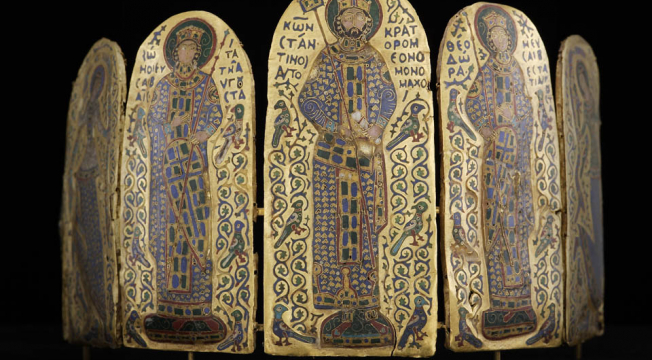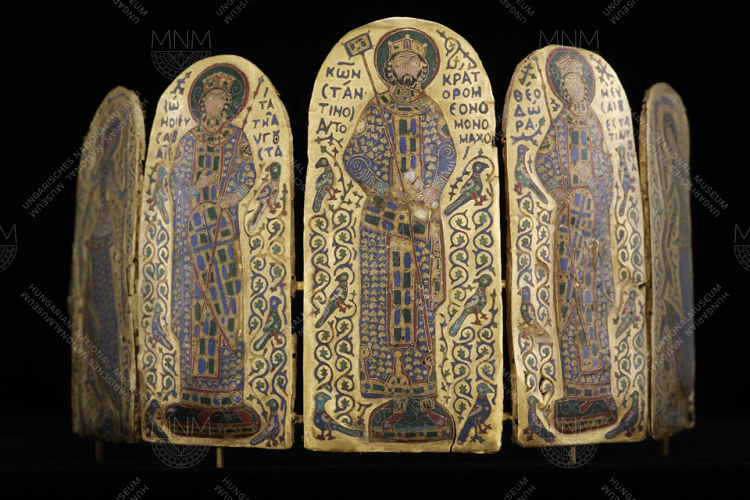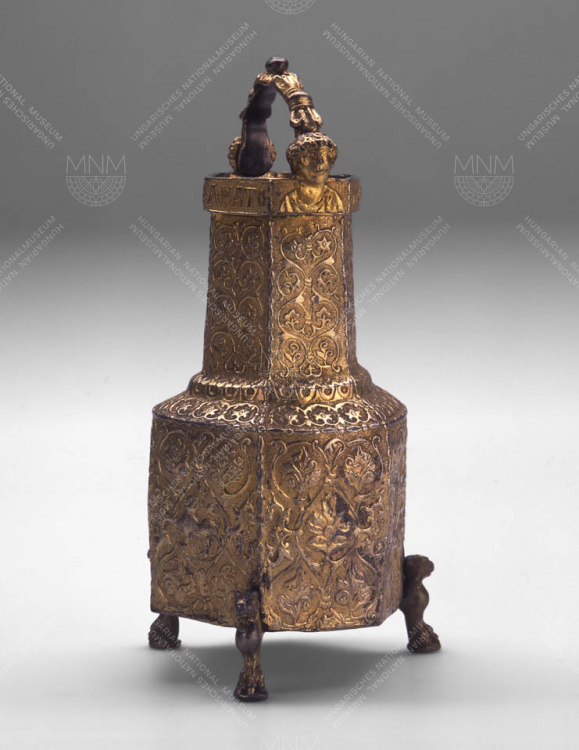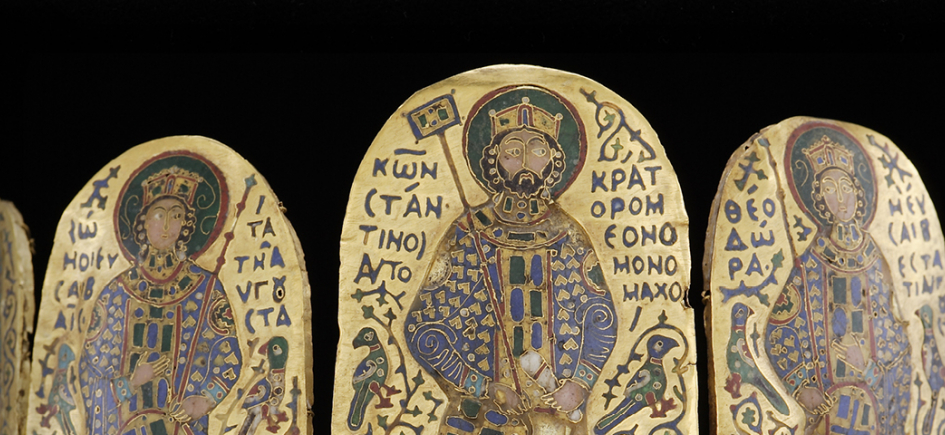
Department of Archaeology
Archaeological Department short description
 2
2
MONOMACHOS CROWN
Crown of Constantine IX Monomachos, Byzantium, 1042–1050
The assemblage consists of seven gold plates each of which has a semi-circular top and cloisonné enamel decoration. It was recovered at Nyitraivánka (Ivanka pri Nitre, Slovakia) in 1861. The plates depict, respectively, Constantine IX Monomachos, emperor of the ‘Romans’, (r. 1042–1055), and six standing female figures; there are also two medallions featuring busts of the apostles and brothers St. Peter and St. Andrew respectively. The assemblage contains three pairs of gold plates, each of a different height. Two of the gold plates show the last members of the Macedonian dynasty: Zoe (d. 1050) and her sister Theodora (d. 1056) respectively. Two others each depict a dancer, and another two Justice and Humility respectively. The figures are flanked by decoration consisting of trailer and birds and (in the case of the Virtues) pairs of cypresses. The plates may originally have been attached to a cap and may be interpreted as a universal peace programme in a Sassanid, Islamic, antique, and Old Testament context alike. For their part, the two apostles, included in the assemblage in a secondary role, refer to Rome and Constantinople, locations associated with their respective activity, as well as to the Latin and Greek churches they respectively led.

BYZANTINE VESSEL FOR HOLY WATER, FROM BESZTEREC
Second half of the 10th century
This Byzantine silver-gilt holy water vessel inscribed in Greek rests on three – in part reconstructed – lion-griffin feet. On a hexagonal base, the broader lower part of its body is connected to the narrower upper part by a stepped element. On the top, there is a handle, which moves. This is connected to the vessel by means of busts of two youths, and, at the level of the chests of the youths, a damaged inscription in Greek can be seen. The present teading of this is ‘Christ, the living fount of healing’. The vessel is covered by trailer with palmettes on a ground decorated with circles consisting of punched dots. In a lower, oval-shaped space, three palmettes alternate with three mythological beasts. The palmettes are early relics of the so-called flower-and-leaf decoration renewed at the imperial court at Byzantium in the mid-10th century on the basis of Chinese examples.
MONOMACHOS CROWN
Crown of Constantine IX Monomachos, Byzantium, 1042–1050
The assemblage consists of seven gold plates each of which has a semi-circular top and cloisonné enamel decoration. It was recovered at Nyitraivánka (Ivanka pri Nitre, Slovakia) in 1861. The plates depict, respectively, Constantine IX Monomachos, emperor of the ‘Romans’, (r. 1042–1055), and six standing female figures; there are also two medallions featuring busts of the apostles and brothers St. Peter and St. Andrew respectively. The assemblage contains three pairs of gold plates, each of a different height. Two of the gold plates show the last members of the Macedonian dynasty: Zoe (d. 1050) and her sister Theodora (d. 1056) respectively. Two others each depict a dancer, and another two Justice and Humility respectively. The figures are flanked by decoration consisting of trailer and birds and (in the case of the Virtues) pairs of cypresses. The plates may originally have been attached to a cap and may be interpreted as a universal peace programme in a Sassanid, Islamic, antique, and Old Testament context alike. For their part, the two apostles, included in the assemblage in a secondary role, refer to Rome and Constantinople, locations associated with their respective activity, as well as to the Latin and Greek churches they respectively led.

BYZANTINE VESSEL FOR HOLY WATER, FROM BESZTEREC
Second half of the 10th century
This Byzantine silver-gilt holy water vessel inscribed in Greek rests on three – in part reconstructed – lion-griffin feet. On a hexagonal base, the broader lower part of its body is connected to the narrower upper part by a stepped element. On the top, there is a handle, which moves. This is connected to the vessel by means of busts of two youths, and, at the level of the chests of the youths, a damaged inscription in Greek can be seen. The present teading of this is ‘Christ, the living fount of healing’. The vessel is covered by trailer with palmettes on a ground decorated with circles consisting of punched dots. In a lower, oval-shaped space, three palmettes alternate with three mythological beasts. The palmettes are early relics of the so-called flower-and-leaf decoration renewed at the imperial court at Byzantium in the mid-10th century on the basis of Chinese examples.









